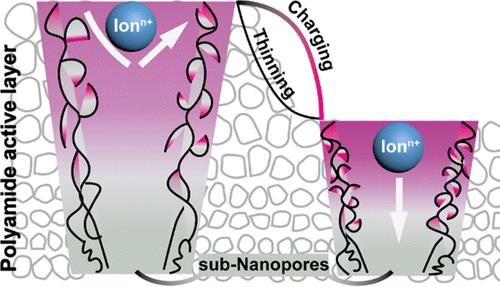当前位置:
X-MOL 学术
›
Environ. Sci. Technol.
›
论文详情
Our official English website, www.x-mol.net, welcomes your feedback! (Note: you will need to create a separate account there.)
Modulating the Asymmetry of the Active Layer in Pursuit of Nanofiltration Selectivity via Differentiating Interfacial Reactions of Piperazine
Environmental Science & Technology ( IF 11.4 ) Pub Date : 2022-09-23 , DOI: 10.1021/acs.est.2c04124 Yawei Gao 1 , Yangying Zhao 2 , Xiao-Mao Wang 1 , Chuyang Tang 3 , Xia Huang 1
Environmental Science & Technology ( IF 11.4 ) Pub Date : 2022-09-23 , DOI: 10.1021/acs.est.2c04124 Yawei Gao 1 , Yangying Zhao 2 , Xiao-Mao Wang 1 , Chuyang Tang 3 , Xia Huang 1
Affiliation

|
Nanofiltration (NF), highly prospective for drinking water treatment, faces a challenge in simultaneously removing emerging contaminants while maintaining mineral salts, particularly divalent cations. To overcome this challenge, NF membranes possessing small pores concomitant with highly negatively charged surfaces were synthesized via a two-step fabrication strategy. The key is to generate a polyamide active layer having a loose and carboxyl group-abundant segment on top and a dense barrier segment underneath. This was achieved by restrained interfacial polymerization between trimesoyl chloride and partly protonated piperazine to form a highly depth-heterogeneous polyamide network, followed by second amidation in an organic environment to remove untethered polyamide fragments and associate malonyl chlorides with reserved amine groups to introduce more negative charges. Most importantly, on first-principle engineering the spatial architecture of the polyamide layer, amplifying asymmetric charge distribution was paired with the thinning of the vertical structure. The optimized membrane exhibits high salt/organic rejection selectivity and water permeance superior to most NF membranes reported previously. The rejections of eight emerging contaminants were in the range of 66.0–94.4%, much higher than the MgCl2 rejection of 41.1%. This new fabrication strategy, suitable for various diacyl chlorides, along with the new membranes so produced, offers a novel option for NF in potable water systems.
中文翻译:

通过区分哌嗪的界面反应来调节活性层的不对称性以追求纳滤选择性
纳滤 (NF) 具有很高的饮用水处理前景,它面临着在同时去除新出现的污染物的同时保持矿物盐,特别是二价阳离子的挑战。为了克服这一挑战,通过两步制造策略合成了具有小孔和高负电荷表面的 NF 膜。关键是要生成一种聚酰胺活性层,其顶部具有松散且富含羧基的链段,而其下方则具有致密的阻隔链段。这是通过均苯三甲酰氯和部分质子化的哌嗪之间的受限界面聚合形成高度非均质的聚酰胺网络来实现的,然后在有机环境中进行第二次酰胺化以去除未连接的聚酰胺碎片并将丙二酰氯与保留的胺基团结合以引入更多的负电荷。最重要的是,在聚酰胺层空间结构的第一性原理工程中,放大不对称电荷分布与垂直结构的变薄相结合。优化后的膜表现出高盐/有机物截留选择性和水渗透性,优于之前报道的大多数 NF 膜。八种新兴污染物的剔除率在 66.0-94.4% 范围内,远高于 MgCl 优化后的膜表现出高盐/有机物截留选择性和水渗透性,优于之前报道的大多数 NF 膜。八种新兴污染物的剔除率在 66.0-94.4% 范围内,远高于 MgCl 优化后的膜表现出高盐/有机物截留选择性和水渗透性,优于之前报道的大多数 NF 膜。八种新兴污染物的剔除率在 66.0-94.4% 范围内,远高于 MgCl2拒绝率为41.1%。这种适用于各种二酰氯的新制造策略以及由此生产的新膜,为饮用水系统中的 NF 提供了一种新的选择。
更新日期:2022-09-23
中文翻译:

通过区分哌嗪的界面反应来调节活性层的不对称性以追求纳滤选择性
纳滤 (NF) 具有很高的饮用水处理前景,它面临着在同时去除新出现的污染物的同时保持矿物盐,特别是二价阳离子的挑战。为了克服这一挑战,通过两步制造策略合成了具有小孔和高负电荷表面的 NF 膜。关键是要生成一种聚酰胺活性层,其顶部具有松散且富含羧基的链段,而其下方则具有致密的阻隔链段。这是通过均苯三甲酰氯和部分质子化的哌嗪之间的受限界面聚合形成高度非均质的聚酰胺网络来实现的,然后在有机环境中进行第二次酰胺化以去除未连接的聚酰胺碎片并将丙二酰氯与保留的胺基团结合以引入更多的负电荷。最重要的是,在聚酰胺层空间结构的第一性原理工程中,放大不对称电荷分布与垂直结构的变薄相结合。优化后的膜表现出高盐/有机物截留选择性和水渗透性,优于之前报道的大多数 NF 膜。八种新兴污染物的剔除率在 66.0-94.4% 范围内,远高于 MgCl 优化后的膜表现出高盐/有机物截留选择性和水渗透性,优于之前报道的大多数 NF 膜。八种新兴污染物的剔除率在 66.0-94.4% 范围内,远高于 MgCl 优化后的膜表现出高盐/有机物截留选择性和水渗透性,优于之前报道的大多数 NF 膜。八种新兴污染物的剔除率在 66.0-94.4% 范围内,远高于 MgCl2拒绝率为41.1%。这种适用于各种二酰氯的新制造策略以及由此生产的新膜,为饮用水系统中的 NF 提供了一种新的选择。


























 京公网安备 11010802027423号
京公网安备 11010802027423号